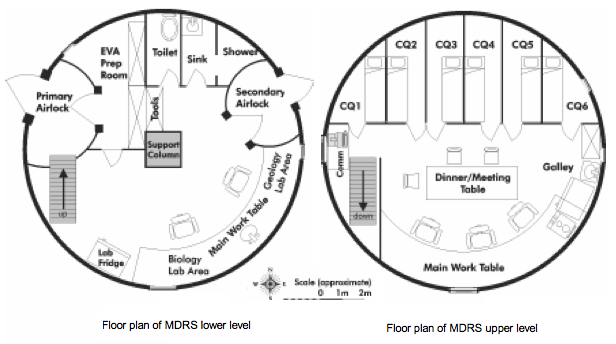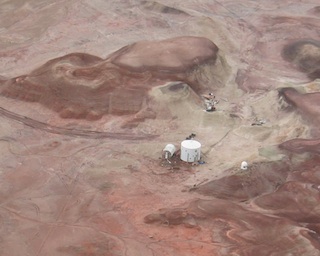<div id="kmnav2">
- [Overview]
- Upper Level
- Lower Level
- Airlocks
- Crew Quarters
- Greenhouse
- Engineering
- Observatory
- Rovers
Unknown macro: {html}
</div>

Analogue Research Stations are laboratories for learning how to live and work on another planet. Each is a prototype of a habitat that will land humans on Mars and serve as their main base for months of exploration in the harsh Martian environment. Such a habitat represents a key element in current human Mars mission planing. Each Station's centerpiece is a cylindrical habitat, "The Hab," an 8-meter diameter, two-deck structure mounted on landing struts. Peripheral external structures, some inflatable, may be appended to the Hab as well.
Features visible in the picture:
- [Airlock] door: Entry to a small room, where crew members wait while the room is 'pressurised'. At MDRS, this is simulated using a 5-minute time delay. There is a similar airlock called 'engineering' or secondary airlock on the opposite side.
- Greenhouse: Contains the water recycling system at the front and the glasshouse at the back.
- Satellite dish: Enables the communication via internet with the crew. The bandwidth is very restrictive, 450 Mb/day that includes sending all daily reports to Mission Support Mars, photos and keeping webcams live.
- Observatory: Harbours a Celestron CGE 1400 Telescope that uses a STV Deluxe ST2000 XM camera for taking digital images of the night sky.
- Rovers: 4 individual rovers are provided to the crew: Viking, Opportunity I, Opportunity II and .... There is also a 'pressurised rover' (4WD) for longer trips or to be used in emergencies.
- Solar Panels
- Weather station

Live Webcam
<img style="border: 1px solid;" id="webcam" src="http://www.freemars.org/mdrscam/outside/MDRS-astro-cam.jpg" name="webcam" width="320" height="240"/><br/>
Image refreshes in <b id="countDownText">0</b> seconds.<br/>
<script type="text/javascript">
<!--
var countDownInterval=180;
var countDownSecondsIncrement=1;
var countDownTime=countDownInterval;
function reloadImg(object) {
uniq = new Date();
uniq = "?"+uniq.getTime();
newImage = object.src;
index = newImage.indexOf("?", 0);
if (index > 0)
object.src = newImage+uniq;
}
function countDown() {
countDownTime=countDownTime-countDownSecondsIncrement;
if (countDownTime < 0)
document.all.countDownText.innerText = countDownTime;
setTimeout("countDown()", countDownSecondsIncrement * 1000);
}
document.all.countDownText.innerText = countDownTime; // Set initial time
setTimeout("countDown()", countDownSecondsIncrement * 1000);
// -->
</script>
Aerial View
Click on the image for a larger view.
Image courtesy of Doug Martin, Mars Society at Georgia Tech.
